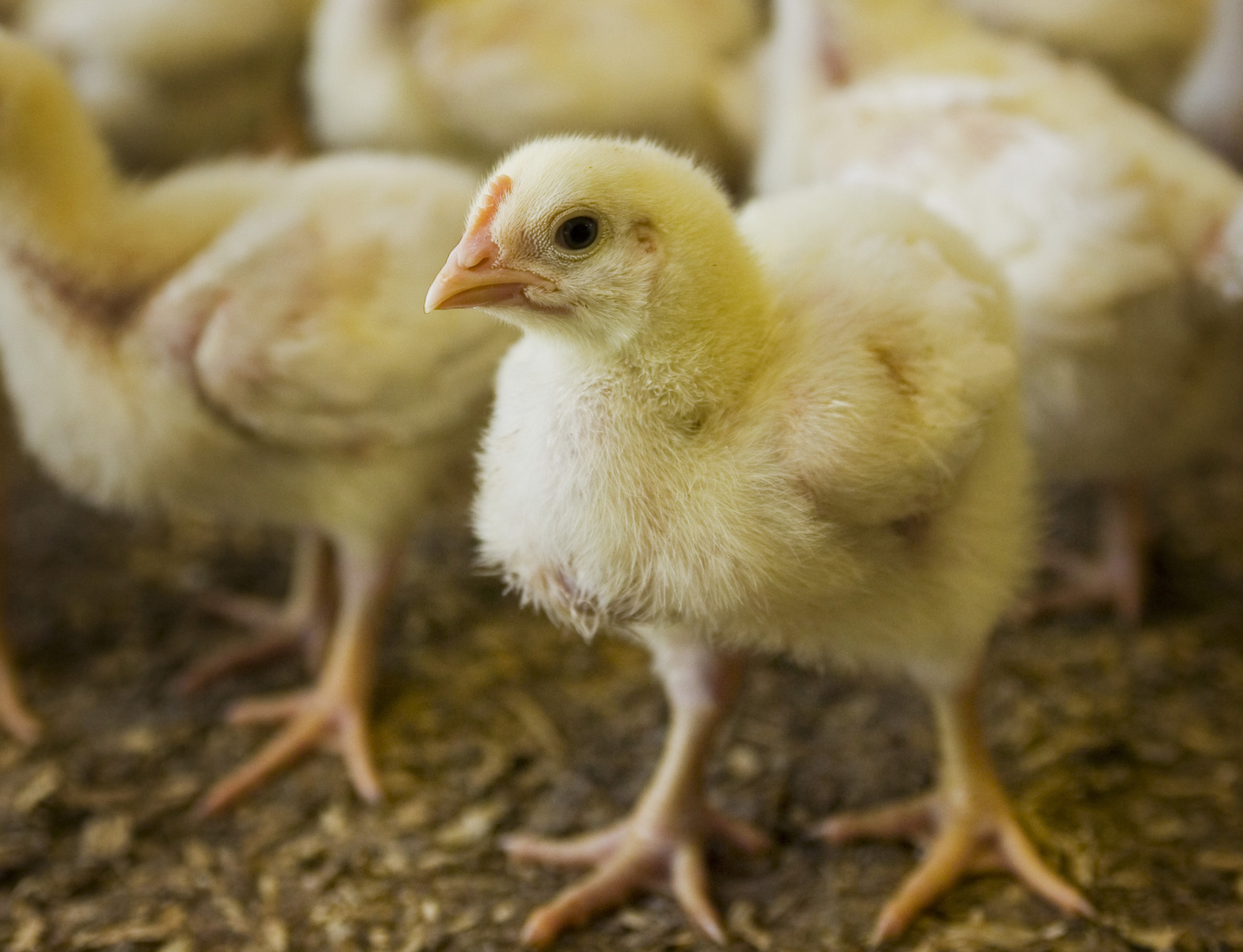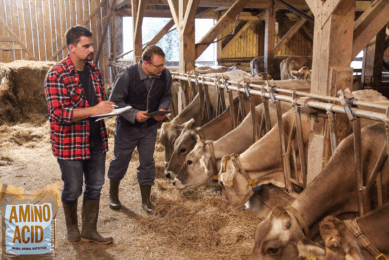Better feed efficiency with naturally sourced betaine

Betaine supplementation has ?numerous positive effects on animal performance. Recent studies with betaine from sugar beet molasses looked if this naturally derived betaine can substitute a certain amount of added methionine in broiler diets.
Betaine (BET) or trimethylglycine is a zwitterionic (neutral molecule with bipolar structure) quaternary ammonium compound. It was first discovered in the juice of sugar beets (Beta vulgaris) and afterwards found in other plants (spinach) animals (shrimps, shellfish) and microorganisms. BET is synthesized from choline (CHOL) by choline oxidase (Zhang et al., 2013) in the cell mithocondria. Over the last years BET is widely used in the animal feed business for its two main physiological functions: osmolyte property and methyl donor. They are briefly discussed here.
BET helps animals under heat stress conditions
BET helps to maintain cell volume (Klasing et al., 2002) and increases intracellular water retention as it is considered a non-ionic osmolyte (unlike Na+ and K+), this allows it to accumulate in cells without disrupting normal functions. This function plays a key role especially when animals are under heat stress conditions (Yancey et al., 1982), helping the animals to restore their acid-base balance and as consequence, BET increases the breast meat yields in the carcass of broilers (Esteve-Garcia & Mack, 2000) caused among others by the high water holding capacity of the muscles. During heat stress more BET will be formed from CHOL in order to minimise its effects (Craig, 2004).
CHOL content not sufficient in typical corn-soybean-based broiler diet
Betaine acts as a methyl donor to convert homocysteine into methionine (MET). According to Craig (2004) MET is converted to S-adenosylmethionine (SAM) which donates a methyl group for most methylation reactions in the body such as synthesis of RNA, protein and lipids (Yasuhiko et al., 1982; Wu et al., 2012). Then the remaining SAM molecule becomes S-adenosylhomocysteine (SAH) and it ends up with homocysteine formation which can either be used for amino acid synthesis (e.g. cysteine) or be re-methylated to MET through BET, therefore starting another cycle. This is why BET is considered actually as a MET but also a CHOL sparing nutrient as it is synthesised from CHOL by choline oxidase. According to Pillai et al. (2006) the homocysteine re-methylation rate increases when either CHOL or BET are supplemented to broilers that are being fed a MET deficient diet. Pesti et al. (1979) stated that in a typical corn-soybean-based broiler diets the CHOL content is not sufficient to supply the cell requirements for methylated compounds as it is known as a key nutrient involved in the synthesis of phospholipids and cell membranes, and in the synthesis of neurotransmitter acetylcholine (Rompala & King, 1995; Stryer, 1995) being actually deviated from its essential role when it is oxidized into BET (Kidd et al., 1997). Carnitine is one of the products formed from the methyl radical, donated by SAM and that is why BET is considered a lipotropic agent (Jahanian & Rahmani, 2008), since it is indirectly involved in the lipid metabolism. Carnitine acts as an obligatory cofactor for oxidation of fatty acids by facilitating the transport of long-chain fatty acids across the mitochondrial membrane as acylcarnitine esters (Borum, 1983). In the liver a high concentration of carnitine promotes fatty acid oxidation and as consequence it reduces the amount of long-chain fatty acids available in adipose tissue thereby reducing the abdominal fat content (Zhan et al., 2006). Two BET sources are on the market nowadays. The most common one is the BET anhydrous extracted from sugar-beet molasses (a by-product of sugar industry) but more recently also synthetic BET hydrochloride is available. According to the literature, both sources have equal nutritional properties (University of Ghent, 2010; unpublished). However, more research has to be done in order to compare the effectiveness of both sources by supplementing diets deficient either in MET or CHOL or both.

Betaine, derived from sugar beet molasses, is a well-known multifunctional nutrient that exerts a number of important physiological functions at the gastrointestinal and metabolic level.
Methionine primary constituent of structural proteins
Considered the first limiting amino acid in poultry, MET cannot be synthesised by the bird thus it has to be supplied via the diet to meet his total sulfur amino acid requirement. Besides its methyl donor properties and precursor of cysteine (which is the precursor of carnitine and glutathione protecting cells against oxidative stress), MET is the primary constituent of structural proteins and it is related with the synthesis of proteins in the immune system (Grimble, 2006). In the last few years supplementation of synthetic MET became a key concern in feed formulation. Free MET can be added to the diet mainly as either DL-methionine or methionine hydroxy analogue. Even though BET cannot replace these compounds completely in poultry diets (Kidd et al., 1997; Metzler-Zebeli et al., 2009), it can partially replace them when they are deficient in diets (Zhan et al., 2006; Attia et al., 2005). Due to the metabolic interrelation between BET, CHOL and MET, several studies were carried out in broiler chickens in order to investigate the effect of supplementing BET in a CHOL, MET or CHOL/MET deficient diets. These studies found varying results which were mostly due to aspects such as the amount of BET and/or CHOL supplemented, the BET chosen, the amount of total sulphur amino acids used, environmental conditions, response parameters measured among others.
Study in broiler chickens
Based on this, a recent trial was carried out in the Netherlands which aimed to determine the effect of BET supplementation – in diets deficient in MET and CHOL – on productive performance of broiler chickens during the growing phase (d 10-28), as well as to compare the effectiveness of four different BET sources. Two of the betaine sources, ActiBeet® VC and ActiBeet® L (hereafter called product 1 and product 2), are produced by Agrana through a chromatographic separation process of their sugar beet molasses. This process enables the company to separate the molasses into three different fractions, one of which is a natural, betaine rich, desugared fraction. In the study, four products were tested: ActiBeet® VC (complementary feed with 40% natural source of betaine), ActiBeet® L- (sugar) beet molasses (partially desugared (04.10.05 in Positive List and 4.1.5 acc. to Reg. (EU) No 68/2013), with 40% natural source of betaine), product C (betaine anhydrous 96% – natural source) and product D (betaine hydrochloride 70,7% – synthetic source). The study was conducted by a feed research institute in the Netherlands – 840 day old Ross 308 broilers were allocated in 7 treatments with 6 replicates of 20 birds (42 floor pens in total), males and females in separated pens between d 10-28 of age.
| Dietary treatments consisted of: | |
| T1: | no added MET and CHOL → d. M+C/d. Lys ratio = 0.63 (-10% of standard) |
| T2: | T1 + 0.7 g/kg of MET from DL-MET → d. M+C/d. Lys ratio = 0.70 (at standard) |
| T3: | T1 + 0.7 g/kg CHOL from choline chloride |
| T4: | T1 + 0.7 g/kg BET from ActiBeet® VC (product 1) |
| T5: | T1 + 0.7 g/kg BET from ActiBeet® L (product 2) |
| T6: | T1 + 0.7 g/kg BET from Product C |
| T7: | T1 + 0.7 g/kg BET from Product D |

All treatments had the same pelleted basal diet (T1), based on maize, wheat and soybean meal with a CP level at 19,84 % and the energy level ME of 3000 kcal/ kg. Results between d 10-28 are described in Table 1 where no interaction between treatment and sex was observed in any trait (P > 0.05). zoom in for table
Broiler performance with different products
Table 1 shows that no difference among treatments containing BET sources were observed and that the three of them did not differ by adding DL-MET diet (P > 0.05). Nevertheless, birds fed the treatment containing BET from “Product D” had the closest FCR in comparison with those fed the NC diet (P > 0.05). Similar results was observed when an adjusted FCR was determined for broiler performance comparison, by taking 1.5 kg of live weight as reference as shown in Figure 1. For the calculation every 100 g of variation in BWG was considered to be equal to 3 points of FCR. Results observed from d 10-28 of age indicate that both product 1 and product 2 were able to give similar or even better performance in comparison with the other two BET products, when compared with the NC diet or NC diet supplemented with DL-MET or CHOL. In other words, the outcomes of this trial show that in the d. M+C / d. Lys ratios assessed (0.70 and 0.63), 0.7 g/kg DL-MET can be replaced by equal amount of natural betaine sources, either product 1, product 2 or “Product C” without impairing performance which means that they were able to spare MET at the d. M+C / d. Lys ratios studied. Nevertheless 0.7 g/kg of CHOL was not able to replace equal amount of DL-MET.
Potential to substitute some methionine
These results confirm the findings of Rama Rao et al. (2011), who observed that 0.8 g/kg of added BET from sugar-beet molasses was able to replace 0.7 g / kg of added MET in diets containing on average a d. M+C / d. Lys ratio of 0.64; in comparison with normal diets containing a ratio of 0.71 in Cobb 500 male broilers from d 0-42 of age. In addition, Zhan et al. (2006) concluded that 0.05% BET supplementation in growing broiler diets that were moderately deficient in MET had the same efficiency compared with MET in improving performance and carcass quality. In contrast other studies showed a lack of improvement in performance; Rostagno & Pack (1996), Esteve-Garcia & Mack, (2000) and Lukic et al., (2012) stated that BET might not be able to be substituted for MET without causing negative effects. In conclusion, the addition of BET can be a potential substitute for a certain amount of added MET in broiler diets. In this study we observed that at a dietary level of 10.73 g of d. Lys / kg diet with an increase in the d. M+C / d. Lys ratio from 0.63 to 0.70 improved technical results between d 10-28 of age. Addition of BET to diets with a d. M+C / d. Lys ratio of 0.63 gave similar performance. In order to draw a conclusion on the relative efficacy of BET to MET, slope-ratio techniques at MET deficient levels should be used.
References are available on request (barbara.auer@agrana.com).











